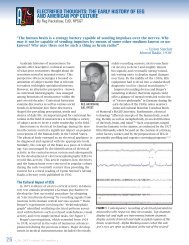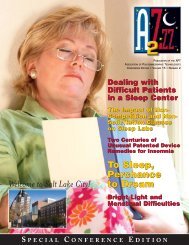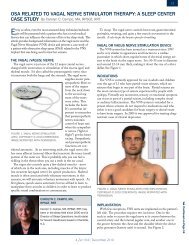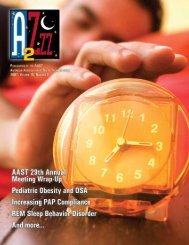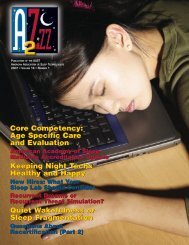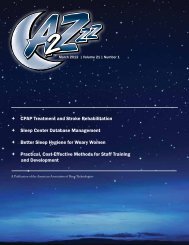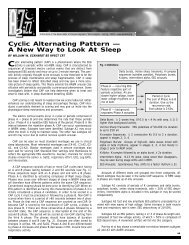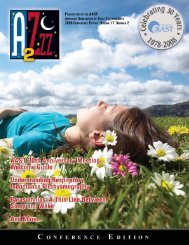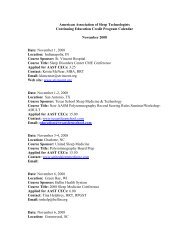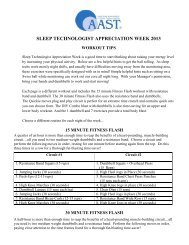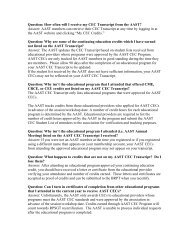APT Practice Parameter for Standard Polysomnography APT ...
APT Practice Parameter for Standard Polysomnography APT ...
APT Practice Parameter for Standard Polysomnography APT ...
- No tags were found...
You also want an ePaper? Increase the reach of your titles
YUMPU automatically turns print PDFs into web optimized ePapers that Google loves.
<strong>APT</strong> NewZzzPublication of the Association of Polysomnographic Technologists • 2006, Volume 15, Number 4 • www.aptweb.org2.3 Routine <strong>for</strong> <strong>Standard</strong> PSGThe protocol of the standard PSG should be clearly established by thesleep facility. Detailed clinical in<strong>for</strong>mation about the patient’s sleep-relatedproblem as well as a medical history is necessary. The sleep technologistshould apply the required electrodes and monitoring devices to monitor thechannels listed in the montage. The sleep technologist will begin the recordingafter insuring that impedances are acceptable, sensors and equipmentare functioning properly and all calibrations have been per<strong>for</strong>med. “LightsOut” and “Lights On” times should be clearly documented. The sleep technologistwill continuously monitor the patient’s clinical status, body position,and document changes on the sleep study and/or on a <strong>for</strong>m designed by thesleep facility as defined by written protocol. Ideally, 8 hours of recording timeshould be obtained; however, a minimum of 6 hours is recommended <strong>for</strong> astandard PSG. The sleep technologist will assist the patient as necessaryduring the recording (helping them to the bathroom, addressing com<strong>for</strong>tissues, etc.) Intervention with therapy (oxygen, PAP) may be initiated per thefacility’s protocol. After “Lights On” procedures have been per<strong>for</strong>med, theelectrodes and monitoring devices should be removed with care and cleanedaccording to infection control standards.2.4 Artifact Recognition and CorrectionThe sleep technologist is responsible <strong>for</strong> monitoring and maintaining theintegrity of each recorded channel. This requires that the sleep technologistdifferentiate between normal and abnormal patterns as well as patient-generatedvariations vs. true artifact. Once an artifact is identified, the sleeptechnologist must determine when it is necessary to make appropriateadjustments. Ideally, all channels should be artifact-free during the recording.The sleep technologist should use a systematic approach to troubleshootingartifact by tracing the recorded circuit from the patient to thecomputer monitor. Environmental interference (fans, cell phones, etc.) mayhave an effect on the recording and should be annotated.Typical patient circuit:PATIENT ➞ SENSOR ➞ HEADBOX ➞ AMPLIFIER ➞ COMPUTER3.0 PSG DocumentationThe results of the standard PSG procedure must be presented in a comprehensiveand concise report that summarizes all observations and analysisof the recorded physiological parameters. This report is typically presentedin a chart <strong>for</strong>m containing all paperwork pertaining to the patient’scare at the sleep facility. The sleep technologist is responsible <strong>for</strong> completinga log and summary of the sleep study findings and events. In addition,the sleep technologist is responsible <strong>for</strong> ensuring that all other required documentsare available be<strong>for</strong>e the study begins (history and physical, previoustest results, referral, insurance in<strong>for</strong>mation, bedtime questionnaires, etc.)These documents must also provide an integrated report, highlighting thesleep technologist’s observations of possible medical significance <strong>for</strong> theinterpreting physician. The following sections delineate the minimal in<strong>for</strong>mationthat should be included in technical documents. 103.1 Patient IdentificationIn compliance with the Health Insurance Portability and AccountabilityAct (HIPAA), the PSG data and all reports should be clearly labeled on eachpage with the patient’s full name, date of birth and date of the study. Anyadditional in<strong>for</strong>mation, such as identification numbers required <strong>for</strong> retrievalcan also be included. Likewise, all long-term storage mediums should be adequatelylabeled.3.2 Patient HistoryThe patient’s chart should contain sufficient history in<strong>for</strong>mation to documentthe reason why the study was recommended, i.e. any significant existingmedical conditions, currents medications, special therapy (i.e. supplementalO2). Any previous special procedures the patient has had that mightinfluence the study results (i.e. LAUP, UPPP, somnoplasty, bariatric surgery)and any previous sleep studies or diagnostic testing such as nocturnal oximetry.This should be accomplished with a complete sleep history questionnairecompleted prior to arrival at the sleep facility as well as receiving a historyand physical from the referring physician. 113.3 Technical Documentation3.3.1 LogThe sleep technologist should log notable events that occur during thestudy in chronological order. Notable events include “Lights Off”, sleep onset,“Lights On”, the sleep technologist entering or leaving the patient’s room, thepatient getting out of bed, initiating or adjusting PAP or oxygen therapy, positionchanges, technical difficulties, environmental disturbances, and anyother observation that might be helpful to the interpreting physician.3.3.2 SummaryThe sleep technologist should completely summarize the technical andbehavioral observations of the standard PSG. This can be done on a <strong>for</strong>mdesigned by the sleep facility or within the context of the <strong>for</strong>mat set <strong>for</strong>th bythe manufacturer of the PSG data acquisition equipment. The summaryshould include comments on sleep architecture behavioral observations,myoclonus/limb movements, respiratory characteristics and heartrate/ECG observations. The sleep technologist should also add any significantmedical or sleep-related in<strong>for</strong>mation discovered during patient assessment,testing, or be<strong>for</strong>e discharge.3.3.3 Sleep <strong>Parameter</strong>sThe report summary should describe should include the details of theanalysis of sleep stage scoring as well as clinical event scoring.3.3.3.1 Sleep Stage <strong>Parameter</strong>sTotal Recording Time (TRT) / Time in Bed (TIB) is defined as the timefrom “lights out” to “lights on”. Total Sleep Time (TST) is the total time asleepafter sleep onset. To determine the how well the patient slept, the SleepEfficiency (SE) is calculated by dividing the TST by the TRT.Sleep studies are gathered on 30 second “epochs”. The unequivocalsleep onset is the first of three consecutive epochs of Stage 1 sleep or thefirst epoch of any other sleep stage. Sleep Onset Latency (SOL) is the timefrom “lights out” to the sleep onset. Latencies to sleep stages are determinedfrom sleep onset to the first epoch of that sleep stage.Wake after Sleep Onset (WASO) is the time awake after sleep onset until“lights on”. To determine the percentage time spent in each of the sleepstages during the sleep study, the total minutes of the sleep stage is dividedby the TST. This percentage can them be compared to normative values todocument the fragmentation of the sleep architecture. 123.3.3.2 Clinical Event <strong>Parameter</strong>sTo determine the severity of the sleep related disturbances, the indicesof the clinical events is compared to normative values. The sleep technologistwill calculate the index by taking the number of clinical events divided bythe TST. These indices include the apnea index (AI), hypopnea index (HI),apnea/hypopnea index (AHI), periodic limb movement (PLM) index, spontaneousarousal index, apnea/hypopnea arousal index, PLM arousal index, andarousal index.Usually the PSG acquisition equipment will analyze the heart rate and oxygensaturation and report the mean, maximum and lowest value by TRT, TSTcontinued on page 1211



